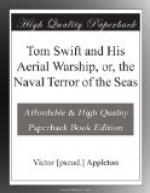“Tom, however did you do it?” gasped Ned at length.
“By hard work,” was the modest reply. “I’ve been at this for a longer time than you’d suppose, working on it at odd moments. I had a lot of help, too, or I never could have done it. And now it is nearly all finished, as far as the ship itself is concerned. The only thing that bothers me is to provide for the recoil of the guns I want to carry. Maybe you can help me with that. Come on, now, I’ll explain how the affair works, and what I hope to accomplish with it.”
In brief Tom’s aerial warship was a sort of German Zeppelin type of dirigible balloon, rising in the air by means of a gas container, or, rather, several of them, for the section for holding the lifting gas element was divided by bulkheads.
The chief difference between dirigible balloons and ordinary aeroplanes, as you all know, is that the former are lifted from the earth by a gas, such as hydrogen, which is lighter than air, while the aeroplane lifts itself by getting into motion, when broad, flat planes, or surfaces, hold it up, just as a flat stone is held up when you sail it through the air. The moment the stone, or aeroplane, loses its forward motion, it begins to fall.
This is not so with a dirigible balloon. It is held in the air by means of the lifting gas, and once so in the air can be sent in any direction by means of propellers and rudders.
Tom’s aerial warship contained many new features. While it was as large as some of the war-type Zeppelins, it differed from them materially. But the details would be of more interest to a scientific builder of such things than to the ordinary reader, so I will not weary you with them.
Sufficient to say that Tom’s craft consisted first of a great semi-rigid bag, or envelope, made of specially prepared oiled silk and aluminum, to hold the gas, which was manufactured on board. There were a number of gas-tight compartments, so that if one, or even if a number of them burst, or were shot by an enemy, the craft would still remain afloat.
Below the big gas bag was the ship proper, a light but strong and rigid framework about which were built enclosed cabins. These cabins, or compartments, housed the driving machinery, the gas-generating plant, living, sleeping and dining quarters, and a pilot-house, whence the ship could be controlled.
But this was not all.
Ned, making a tour of the Mars, as she swayed gently in the big shed, saw where several aluminum pedestals were mounted, fore and aft and on either beam of the ship.
“They look just like places where you intend to mount guns,” said Ned to Tom.
“And that’s exactly what they are,” the young inventor replied. “I have the guns nearly ready for mounting, but I can’t seem to think of a way of providing for the recoil. And if I don’t take care of that, I’m likely to find my ship coming apart under me, after we bombard the enemy with a broadside or two.”




